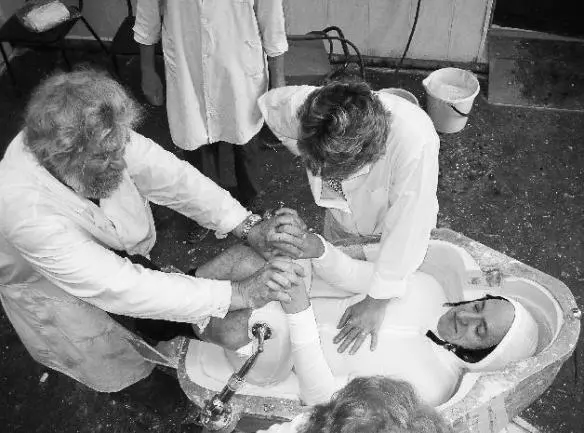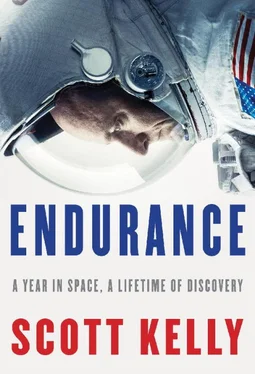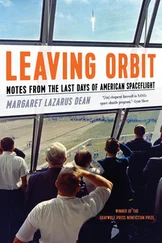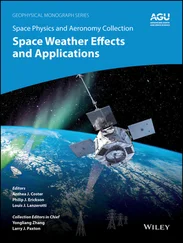Before we can fly on the Soyuz, we must pass oral exams, graded on a scale of one through five, just like the exams given throughout the entire Russian educational system. We took our final exams before a large commission, nearly twenty people in all, who were grading us. We also had a larger audience of spectators. Privately, I referred to the oral exams as a “public stoning.” Part of the process is a postexam debrief in which crew members argue for the grade they believe they have earned, minimizing and avoiding responsibility for any mistakes. This arguing over grades is something like a sport, and it seems we were being graded partly on how we pled our cases. I never wanted to argue—I was willing to take whatever grade the instructors wanted to give me, because I knew that in the end I would soon fly in space regardless.
Some of our training took place at other sites, as we learned to do everything from repairing the equipment on the space station to conducting experiments across many scientific disciplines. One day at the Johnson Space Center, I was in a session with a materials scientist who was teaching a group of astronauts how to use a new piece of equipment on the space station, a furnace for heating materials in zero gravity. While he was explaining the properties of the furnace, he showed us a golf-ball-sized sample of a material that had been “forged” in the furnace and said repeatedly that it was “harder than a diamond.” I found that difficult to believe and asked whether I could hold it. He smiled and handed it to me.
“Is this really harder than a diamond?” I asked.
He assured me that it was.
I put the sample on the floor and raised my heel over it, looking at the scientist questioningly.
“Go ahead,” he said.
I brought down my heel hard and the sample shattered, pieces flying all over the room. Apparently, it wasn’t harder than a diamond. This incident became part of a narrative about me in some people’s minds at NASA—that I didn’t have enough respect for the scientific work being done on the space station. It’s true that I’m not a scientist and that research was never my main motivation for going to space. But even if the science wasn’t what drove me to become an astronaut, I have a profound respect for the pursuit of scientific knowledge and I take my part in that seriously. After all, I would argue, testing that sample from the furnace was an example of using the scientific method to gain knowledge.
Another uniquely Russian spaceflight practice was the creation of custom-molded seat liners for each crew member. The first time I served as a backup crew member, I went to Zvezda, the company that makes the Soyuz seats and Sokol suits, as well as the spacesuits the cosmonauts wear on spacewalks and ejection seats for Russian military aircraft. With a NASA flight surgeon and an interpreter who specializes in medical translation, I traveled to the other side of Moscow from Star City, through many miles of Moscow suburbs. Once inside the guarded and gated Zvezda facility, I was helped into a container like a small bathtub, then had warm plaster poured in all around me. After the plaster hardened, I was helped out, then got to watch while an old weathered technician with a beard like Tolstoy’s—he was really more like an artisan—went to work. I watched his huge, callused hands, with long sensitive fingers like a sculptor’s, carve out the excess plaster to create a perfect mold of my back and butt.
A few weeks later, I came back to Zvezda for a fit check of the newly made seat liner, followed by the dreaded pressure check—an hour and a half on my back in my custom-made spacesuit in my custom-made seat liner with the suit pressurized. The circulation in my lower legs got cut off, and the position became a distinctly painful form of torture. All the cosmonauts and astronauts dread this procedure, but if anyone complains, they are met with a curt answer: “If you can’t deal with this pain now, how can you deal with it in space?” I never bothered arguing about it, but this was a flawed argument; in space you can deal with discomfort that you know is keeping you alive. A few weeks later, I came back for the pressure check again, this time in a vacuum chamber, a ritual meant to give us confidence in the suits. These activities can feel more like ceremonial rites of passage than engineering necessities, as with so many of the traditions in the Russian space program. In the coming years, I would carry out this painful ritual two more times.

Pouring plaster for my Soyuz seat liner. Credit 8 ILLUSTRATION CREDITS Nathan Koga 1, 2, 5, 6, 7, and 8: NASA; 3 and 4: NASA/Scott Kelly Illustrations NASA 9 and 10; Scott Kelly 11 and 12, U.S. Navy 13; NASA 14; NASA 15 and 16; NASA 17 and 18; NASA 19 and 20; NASA 21 and 22; Scott Kelly 23, Stephanie Stoll/NASA 24, NASA 25; NASA/Bill Ingalls 26, NASA 27; NASA 28, NASA/Bill Ingalls 29; NASA/Bill Ingalls 30, NASA 31; NASA 32, NASA/Bill Ingalls 33; NASA/Bill Ingalls 34 and 35; NASA/Bill Ingalls 36, NASA 37; NASA 38 and 39; Scott Kelly/NASA 40, NASA 41; NASA 42, NASA/Scott Kelly 43; NASA 44, NASA/Scott Kelly 45; NASA/Scott Kelly 46, NASA 47; NASA/Scott Kelly 48 and 49; NASA/Scott Kelly 50 and 51; NASA/Bill Ingalls 52 and 53; NASA/Bill Ingalls 54; NASA 55
We traveled to Baikonur two weeks before the scheduled launch date. The last morning, we went through the process of getting suited up, doing our leak checks, and speaking to our loved ones through the pane of glass. We rode the bus out to Gagarin’s launchpad, peed on the tire, and climbed into the capsule. Among the things we had to do to get the vehicle ready was configure the oxygen system, a task that was the responsibility of the flight engineer 2—in this case, me. Toward the end of the launch countdown, I was manipulating one of the O 2valves when we heard a loud squeal. We guessed it was compressed oxygen leaking into the cabin, and we were right. I immediately closed the valve, but we had a massive oxygen leak anytime the valve was taken out of the closed position, which was a requirement during the flight.
At the direction of the ground, Sasha tried to get the situation under control by venting the O 2through the hatch valve into the habitation module above us, then overboard through a valve that led to the outside. He unstrapped himself from his seat so he could sit up to reach the valve directly over his head. I looked at the readings on our LCD screens, paying close attention to the partial pressure of oxygen compared to our total pressure. I did some mental math and calculated that there was close to 40 percent oxygen in the capsule, the oxygen concentration threshold at which many materials become easily flammable with an ignition source, like a small spark.
All astronauts knew that the crew of Apollo 1 had been killed by a fire in their capsule because it had been pumped full of pure oxygen and that a tiny spark caused a conflagration of the Velcro-lined capsule. NASA didn’t use high-pressure oxygen anymore in this way, and they also redesigned the hatch on the Apollo capsule to open outward—and so have all hatches on NASA human-rated launch vehicles since. Not the Russians. The hatch on our Soyuz opened inward, so if there was a fire, the expanding hot gases would put outward pressure on the hatch and trap us, just like the crew of Apollo 1. As Sasha struggled to reach the valves, flailing in his seat, the metal buckles on his straps struck exposed metal on the capsule’s interior. I thought distinctly to myself, This is not a good place to be right now.
Once Sasha was back in his seat and it seemed clear we weren’t going to catch fire, we talked about our predicament. I decided not to voice my concern about the flammability risk.
Читать дальше













